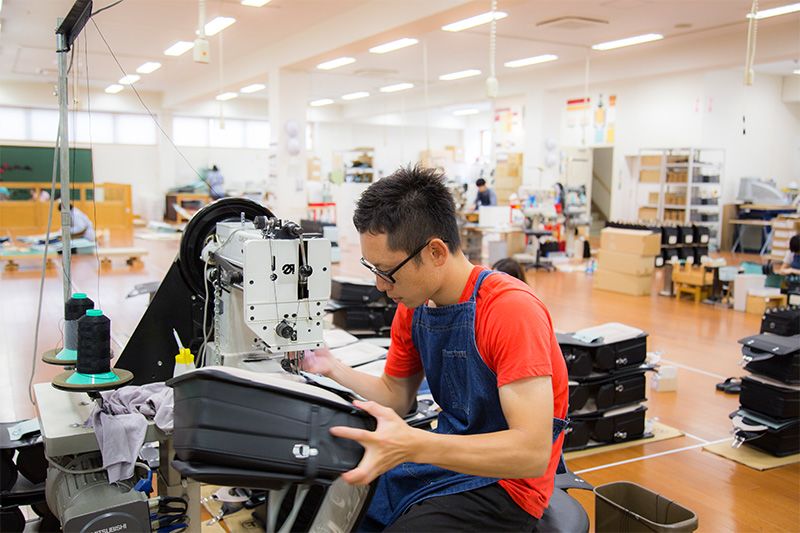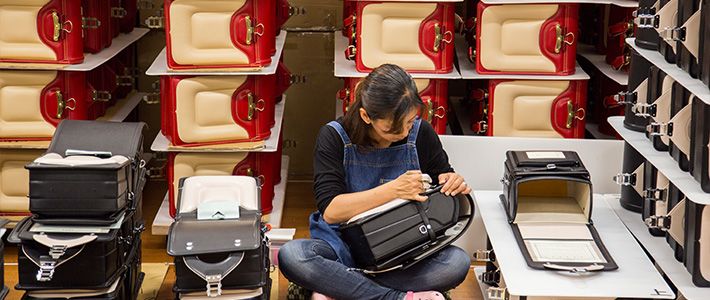
“Cool Traditions” Stay in Tune with Modern Life
Tsuchiya Bag and the Art of the “Randoseru”: The Making of a Timeless Backpack
Culture Lifestyle- English
- 日本語
- 简体字
- 繁體字
- Français
- Español
- العربية
- Русский
The spacious, brightly lit room looks a lot like a school gymnasium, except for the neatly stacked rows of shiny red and black backpacks. Here a group of dedicated artisans are pooling their skills to create something useful, elegant, and virtually indestructible—and all for a bunch of five- and six-year-olds. This is where Tsuchiya Bag (Tsuchiya Kaban) is assembling its eagerly awaited new line of randoseru, the Japanese school backpacks that have recently emerged as a global fashion phenomenon.
“If we produce ten randoseru, we expect ten totally satisfied customers,” says Tsuchiya Kunio, who founded the company that bears his name more than a half-century ago. Wearing the same denim apron as his employees, he looks astonishingly young for his 78 years. “My mission from the start has been to make the finest randoseru in Japan. In a run of 500, we won’t tolerate a single defect. After all, for the customer, it’s all about that one bag.”
A 300-Step Exercise in Perfectionism
Established in 1965, Tsuchiya Bag has become one of Japan’s most respected names in leather goods. Its randoseru are assembled from more than 150 pieces in a yearlong process involving upwards of 300 steps.
Assembly starts with the back panel for which Tsuchiya randoseru are famous. To ensure pillowy softness and a secure fit, the maker uses two layers of cushioning made from two different types of urethane foam. The cushioning is covered with a shell of soft, natural leather for breathability and comfort. Assembled by hand, the back panel features a deeply stitched U-shaped indentation that creates breathing space to prevent buildup of heat and moisture.
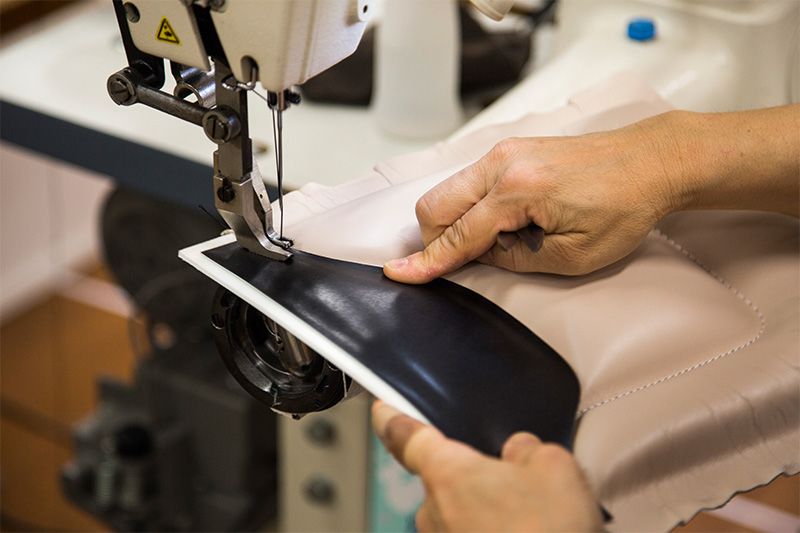 Stitching the padded back panel.
Stitching the padded back panel.
While sewing machines are used for most of the stitching, assembly as a whole is still a painstaking manual process. This is because leather is a natural material that varies in softness, thickness, and texture from one piece to the next. Automated production would result in warping and other irregularities in the finished product.
 (Left) The leather at the bag’s corners is worked by hand into tiny “chrysanthemum folds” designed to minimize damage from scuffing. (Right) The sturdy, finely crafted clasp displays the maker’s logo.
(Left) The leather at the bag’s corners is worked by hand into tiny “chrysanthemum folds” designed to minimize damage from scuffing. (Right) The sturdy, finely crafted clasp displays the maker’s logo.
The goal of all this intensive labor is a comfortable, sturdy, spacious rucksack that will keep its shape and its finish over six years of hard wear. Children will run, jump, and tumble about no matter what. To stand up to such use, Tsuchiya reinforces the side panels with a tough plastic core to prevent the hard-shelled bags from collapsing. The straps are reinforced inside with tape and double-stitched along the borders for durability.
Machine-stitching of these bags is skilled labor. The width of the thread and the length of the stitch must be carefully adjusted to the thickness of the leather, which varies from one step to the next. The stitching cannot fluctuate or swerve by so much as a millimeter. Any unevenness or imbalance in the stitching makes a bag look cheap and crude, says Tsuchiya.
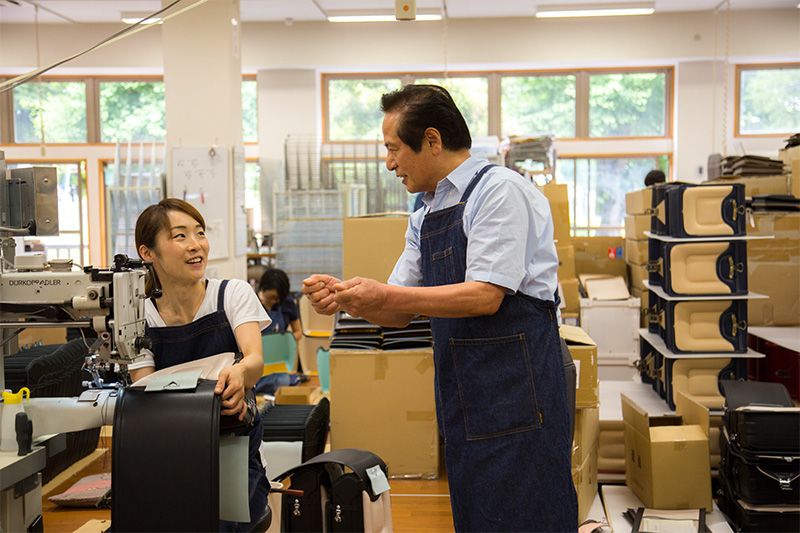 Tsuchiya talks shop with one of his skilled leatherworkers, a machine-sewer with five years’ experience in final assembly.
Tsuchiya talks shop with one of his skilled leatherworkers, a machine-sewer with five years’ experience in final assembly.
Why all the fuss over a school backpack? Parents know their children will carry that bag with them day in and day out for six years. It has to be extremely tough, but also crafted with the kind of classic simplicity of style that will satisfy a 12-year-old just as well as a first-grader. A top-quality randoseru improves with time, as it accumulates layer upon layer of childhood memories.
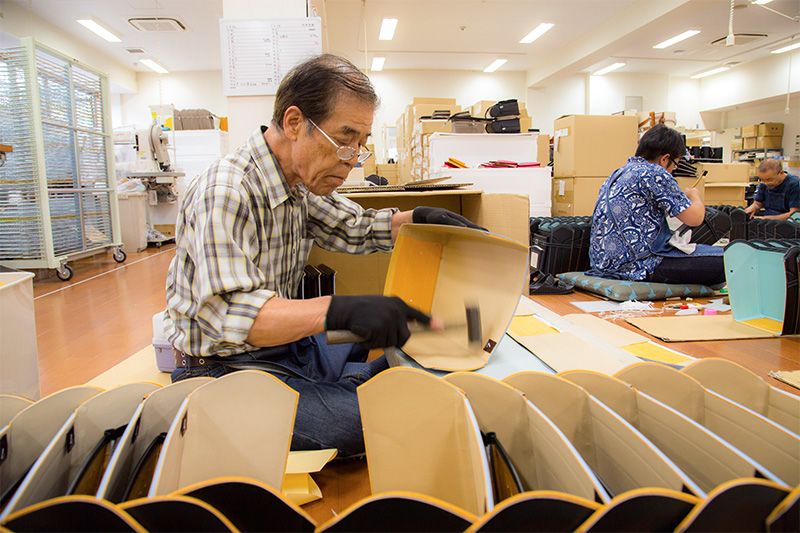 A senior leatherworker attaches the reinforced side panels, which prevent the rigid backpacks from collapsing.
A senior leatherworker attaches the reinforced side panels, which prevent the rigid backpacks from collapsing.
From One-Man Operation to Top of the Line
Tsuchiya was 27 years old when he quit his job with another bag maker to set up shop on his own. Tsuchiya Bag started out as a one-man operation, producing and selling goods in the same small space. It was slow going at first, but gradually word spread through the neighborhood, and the business grew. Validation came when prospective randoseru buyers began dropping in to inspect the bags and then returning to make a purchase after shopping around at department stores and other major retailers. “We were really a small shop, so it was very gratifying when people came back to buy our randoseru after comparing them with the top brands.”
The company has grown considerably since then. Today it has 180 employees, ranging from twenty-somethings to one leatherworker aged 78 (the same as Tsuchiya). The company began hiring young employees for skilled production work in 2002, and the average age of the workforce is now 35. Employees handle all phases of the business in-house, from planning and production to marketing, advertising, sales, and repair. The company has managed to meld the consummate skill of veteran artisans and the fashion sense of younger employees to create a brand with timeless, intergenerational appeal.
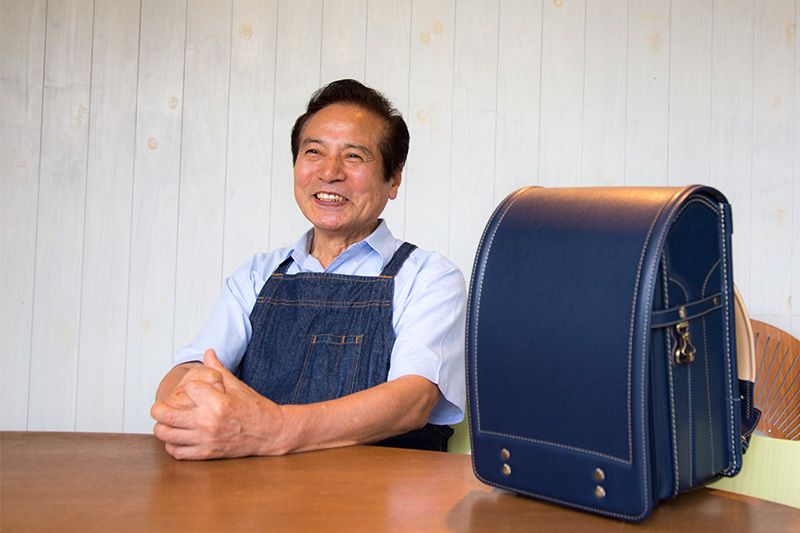 Tsuchiya Kunio, 78-year-old founder of Tsuchiya Bag.
Tsuchiya Kunio, 78-year-old founder of Tsuchiya Bag.
Persnickety Consumers Wanted
On June 9, the day the company unveiled its new randoseru lineup for the 2017 school year, families with young children crowded into Tsuchiya Bag headquarters in Tokyo’s Nishiarai, where its famous backpacks are produced and sold. The company will start taking orders soon, and parents will need to move fast; last year, the bags had sold out completely by mid-September.
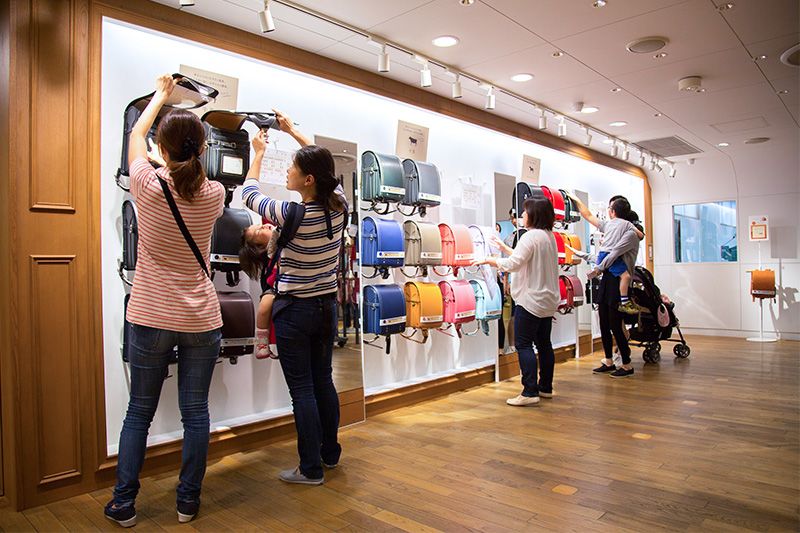 Choosey parents inspect Tsuchiya Bag’s lineup of randoseru for the school year beginning in April 2017. They can choose from 60 style-and-color combinations.
Choosey parents inspect Tsuchiya Bag’s lineup of randoseru for the school year beginning in April 2017. They can choose from 60 style-and-color combinations.
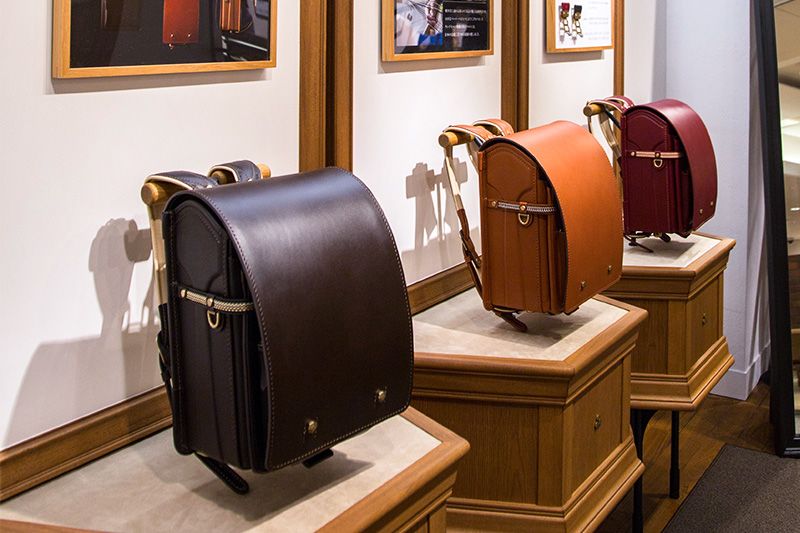 Samples of Tsuchiya’s limited “Karuizawa” randoseru collection, manufactured in the famous resort town of Karuizawa, Nagano Prefecture.
Samples of Tsuchiya’s limited “Karuizawa” randoseru collection, manufactured in the famous resort town of Karuizawa, Nagano Prefecture.
Pastels like pink, lavender, light purple, and combinations thereof are increasingly popular among girls, while black continues to be the go-to color for boys. Natural brown and tan are also reliable sellers. Tsuchiya Bag’s randoseru range in price from ¥56,000 to ¥140,000, including consumption tax. (Shipping within Japan is free; the company does not take overseas orders.) Tsuchiya’s customers generally prefer cowhide, despite the growing popularity of synthetic leather nationwide.
Tsuchiya has built an observation area directly adjoining the store, where customers and their children can witness at least part of the fabrication process at first hand. Parents hope that the sight of all the hard work lavished on each bag will inspire their children to take good care of their pricey randoseru. The leatherworkers draw inspiration from the sight of the children who will rely on their products for years to come.
“We’ve put a lot of work into creating a space where families can savor the experience of selecting a randoseru and look back on it as a fond memory,” says Seino Tomoko, a public relations officer. “Parents often get emotional watching their children put on a randoseru for the first time and realizing how much they’ve grown.”
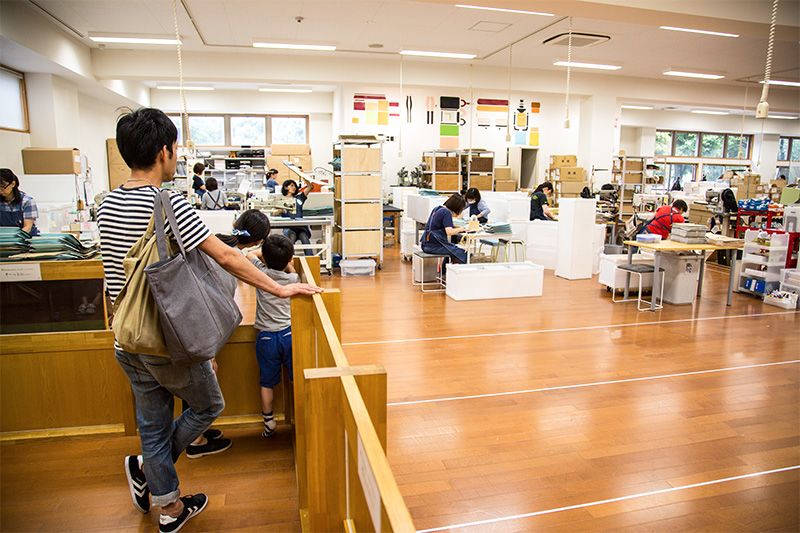 A family watches the assembly process from the special observation area.
A family watches the assembly process from the special observation area.
Targeting a New Market With Adult Randoseru
Tsuchiya is known not just for its children’s randoseru but also for its high-end men’s and women’s bags. To mark its fiftieth anniversary, the company launched a collection of randoseru for working adults, dubbed Otona Randsel.
“The two essential features of the traditional randoseru are their rigid boxlike design, which keeps papers neat and safe, and the fact that they can be carried comfortably on one’s back,” explains Seino. “We’d been thinking for some time about ways to build the same functionality, elegance, and hand-crafted quality into an adult-oriented product. With our fiftieth anniversary approaching, we decided to meet that challenge with two different models of Otona Randsel.” The bags have gone on sale four times now since 2015, and each time they have sold out in one day, notwithstanding the ¥100,000 price tag.
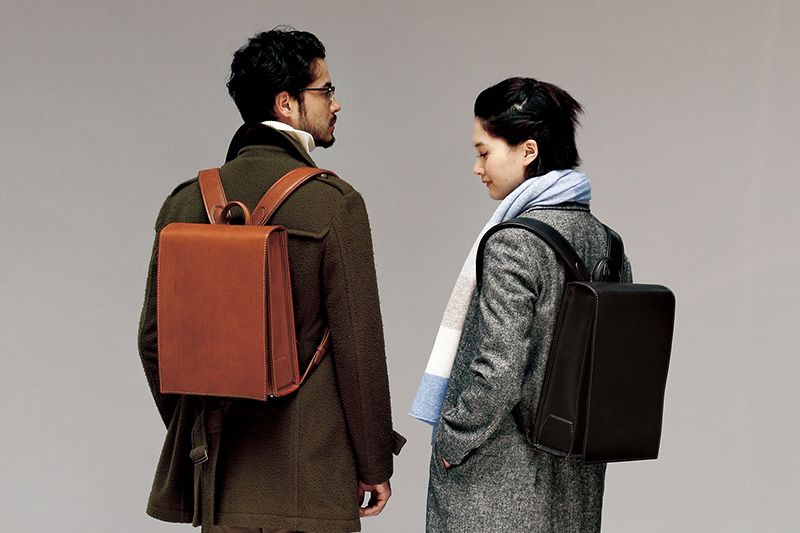 Tsuchiya’s Otona Randsel (adult randoseru) were an instant hit in Japan. Photo Courtesy of Tsuchiya Bag.
Tsuchiya’s Otona Randsel (adult randoseru) were an instant hit in Japan. Photo Courtesy of Tsuchiya Bag.
The basic randoseru form has evolved in response to Japan’s particular social, cultural, and physical circumstances. Even so, the bags’ distinctive aesthetic and functional attributes seem to resonate overseas, where randoseru have emerged as a coveted fashion accessory. Tsuchiya hopes that the randoseru phenomenon will spread as makers develop new styles adapted to local needs and tastes.
If Tsuchiya Bag’s obsession with quality and durability seems an anachronism in this day and age, its customers haven’t noticed. Nor have its employees. Young and old, they seem to have embraced the old-fashioned sentiment articulated in Tsuchiya’s randoseru catalogue: “Some objects grow more and more dear with use. We want everyone to experience the rewards of a long and deep relationship with one of our backpacks.”
(Originally written in Japanese. Banner photo: A Tsuchiya Bag leatherworker carefully inspects each finished bag. All photos by Ōhashi Hiroshi unless otherwise noted.)
